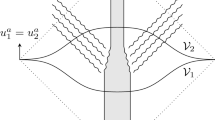Abstract
We derive an expression for the effectivegravitational mass for any closed spacelike 2-surface.This effective gravitational energy is defined directlythrough the geometrical quantity of the freely falling 2-surface and thus is well adapted to intuitiveexpectation that the gravitational mass should bedetermined by the motion of a test body moving freely inthe gravitational field. We find that this effective gravitational mass has a reasonable positivevalue for a small sphere in the non-vacuum space-timesand can be negative for the vacuum case. Further, thiseffective gravitational energy is compared with the quasi-local energy based on the (2 + 2)formalism of General Relativity. Although some gaugefreedoms exist, analytic expressions of the quasi-localenergy for vacuum cases are the same as the effective gravitational mass. Especially, we see that thecontribution from the cosmological constant is the samein general cases.
Similar content being viewed by others
REFERENCES
Arnowitt, R., Deser, S., and Misner, C. W. (1962). Gravitation: An introduction to Current Research, L. Witten, ed. (Wiley, New York). p 227.
Bondi, H., van der Burg, M. G. J., and Metzner, A. W. K. (1962). Proc. Roy. Soc. Lond. A 269, 21.
Sachs, R. K. (1962). Proc. Roy. Soc. Lond. A 270, 103.
Ashtekar, A., and Hansen, R. O. (1978). J. Math. Phys. 19, 1542.
Schoen, R., and Yau, S. T. (1981). Commun. Math. Phys. 97, 231.
Witten, E. (1981). Commun. Math. Phys. 80, 381.
Ashtekar, A., and Magnon-Ashtekar, A. (1979). J. Math. Phys. 20, 793.
Abott, L., and Deser, S. (1982). Nucl. Phys. B 195, 76.
Nakao, K., Shiromizu, T., and Maeda, K. (1994). Class. Quantum Grav. 11, 2059.
Shiromizu, T. (1994). Phys. Rev. D 49, 5026.
Misner, C. W., and Sharp, D. H. (1964). Phys. Rev. B 136, 571; Hawking, S. W. (1968). J. Math. Phys. 9, 598; Bergqvist, G. (1992). Class. Quantum Grav. 9, 1753, and reference therein.
Hayward, S. A. (1994). Phys. Rev. D 49, 831.
Misner, C. W., and Sharp, D. H. (1964). Phys. Rev. B 136, 571.
Ashtekar, A. (1980). In General Relativity and Gravitation, A. Held, ed. (Plenum, New York), vol 2.
Bergqvist, G. (1994). Class. Quantum Grav. 11, 3013.
Horowitz, G. T., and Schmidt, B. G. (1982). Proc. R. Soc. Lond. A 381, 215.
Hayward, S. A. (1993). Class. Quantum Grav. 10, 779.
Regge, T., and Teitelboim, C. (1974). Ann. Phys. 88, 286.
Author information
Authors and Affiliations
Rights and permissions
About this article
Cite this article
Ikumi, K., Shiromizu, T. Freely Falling 2-Surfaces and the Effective Gravitational Mass. General Relativity and Gravitation 31, 73–90 (1999). https://doi.org/10.1023/A:1018815421062
Issue Date:
DOI: https://doi.org/10.1023/A:1018815421062




